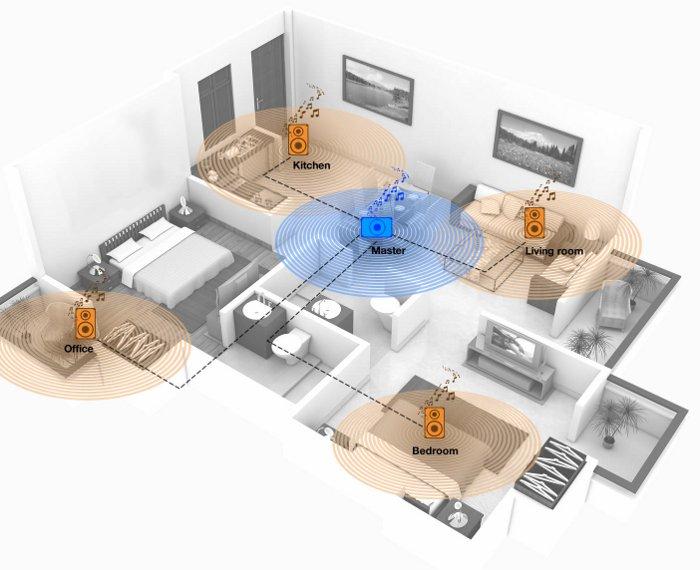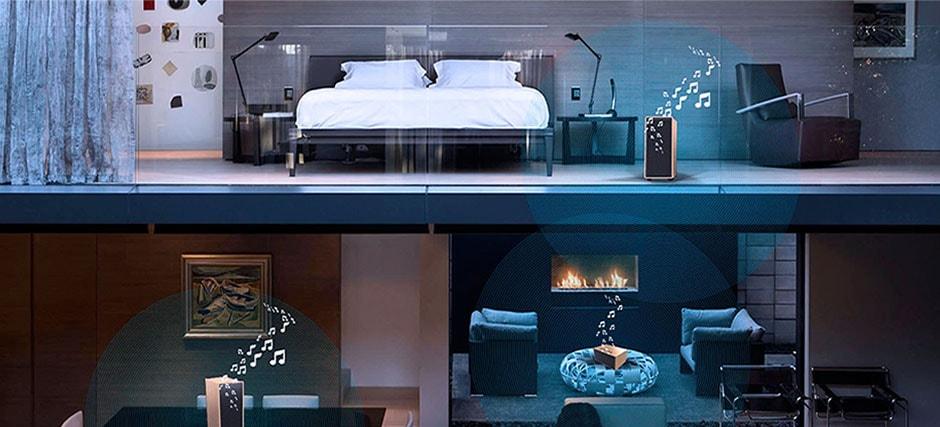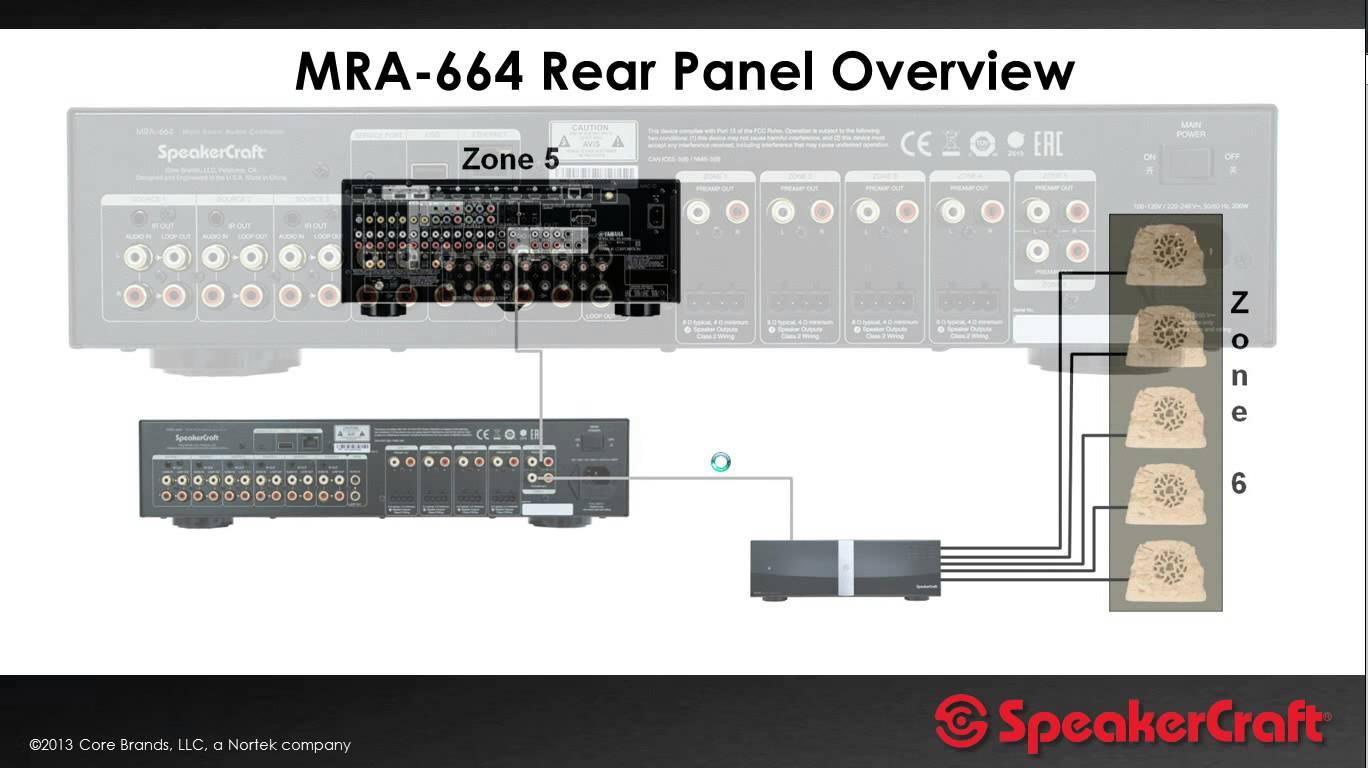Multiroom: The Coming Future of Smart AV and the Beginning of the End of Traditional Systems
Among people who are serious about audio and video equipment, there are often disputes regarding multi-rooms. In traditionalists from audio / video, there is an opinion that multiroom is nothing more than a fashionable trend that does not give real advantages. Exaggerating, we can formulate their point of view with the following statement: “This is all from the evil one,“ not warm ”,“ not a lamp ”figure with excess functionality and integration, invented for lazy soulless technocrats”. Progressive-minded people, on the contrary, are convinced that multi-rooms are a natural stage of technical evolution, which sooner or later will occupy all the niches on the market.

I want to note that critical statements are made by people who are oriented strictly towards the TLZ GM, who hardly understand the charm of the Internet of Things paradigm. In my opinion, these skeptical conclusions about such devices are the manifestation of inertia with respect to innovations and the deliberate disregard of opportunities in favor of well-established ideas and ideological attitudes. It is unnecessary to ask tricky questions about why these old school skeptics do not use VHS for watching videos, and heat their food in the microwave oven, and not on the harsh “warm” skewer over hot coals.
The post demonstrates the advantages of multiroom compared with the traditional architecture of the AV system.
Particularly zealous supporters of ultra-traditionalism in technology, I hasten to disappoint. The material will not be food for trolls who want to argue about the deafness and laziness of techies and "gadget-dependent", "ideological lack of spirituality" multiroom, artifacts in high-end formats, other "harmfulness" and "deadness" of innovation. Adherents of classical switching recommend not to pass by (perhaps some will change the view on multi-room after telling about the capabilities of such systems).
')
The variety of systems, solutions, the difference in their functionality does not allow us to speak of multiroom as a class of devices. Wiki defines Multiroom as a multimedia distribution system for audio and video signals in a certain room or outside it.
I will say more: multiroom is not just a system - it is a principle, the very concept of integrating devices with a single control unit (and / or mobile software), which almost infinitely expands the user's freedom.
It is not uncommon for technology opponents to ask: why is multiroom needed in principle? Like, you can easily place multiple AV systems in each of the rooms in your home and not bother with switches. It should be noted that such an approach is not new, and its shortcomings (financial in the first place) are clear to all those who set up similar experiments.
In contrast to the traditional scheme, when using multiroom for individual rooms, only amplification and acoustics will be needed (alternatively, active acoustics), which is much cheaper than a complete set.

The functional problems of traditional systems with the need for ubiquitous voice acting (all rooms, kitchen, bathroom) are also obvious:
Multiroom acquires special value for people with a pretentious attitude to the design of premises. Such systems are easy to hide and manage through a mobile smartphone application. No less impressive results can be achieved when installing AV equipment in the cottage.

Now produced enough so-called. all-weather acoustics, but with amplification and other equipment for extreme conditions, the situation is more complicated. If necessary, the dubbing of bathrooms, baths, garden pavilions, it is advisable to remove the gain and signal source away fromsin dangerous and unfavorable operating conditions.
The composition of the multiroom system can be very diverse, and is selected in accordance with the needs of the user. The core of the system is the so-called. multiroom source or controller that can combine several audio and video channels, its own local data storage, streaming sources and content access interfaces (Spotify, Deezer, Pandora, TuneIn Radio, etc.), wireless data transmission interfaces.

Management of modern systems is carried out using Android or iOS applications. At the request of the user, cable and satellite receivers, optical players, analog and digital data sources can be integrated into the system (the number of data sources, reproducing devices and areas of their work depends on the specific model and characteristics of the controller).
Simplified multi-rooms are multichannel amplifiers or receivers with mobile integration (control through the application) with the ability to remotely change the source, there are also options with several active speakers united by a single control system. Some companies have formed ready-made kits, already including receivers, controllers, acoustics and switching.
Among the manufacturers represented in our catalog, 62 companies produce this or that equipment for multiroom systems. A special place in this long list is taken by 14 manufacturers, which are produced by multiroom sources (multiroom controllers, multiroom amplifiers, etc.): Cabasse, Bluesound, Denon, Sonos, Klipsch, Axium, Marantz, Kramer, McIntosh, Sonance, Gefen, Digis , SpeakerCraft, Yamaha, URC and MT-Power.
It is difficult to give concrete recommendations in favor of one or another manufacturer. Some systems are likely to be devoted to individual publications. As an example of high functionality and wide capabilities of devices, I cite several descriptions (I stress: not for the sake of advertising, but solely to demonstrate the possibilities).
Speaker Craft MRA-664 is an integrated audio controller designed for 6 sound sources and 12 rooms. The system can be controlled using an iOS or Android mobile application, as well as using a PC or iMac.

The controller allows you to locally store music, use streaming Internet sources. The system can connect any additional sources, such as DVD / CD / Blue Ray-players, cable and satellite receivers. The use of two MRA controllers allows you to create 12 unique zones, each of which can involve up to 6 unique sources.
Specifications
Another possible variant of the core of such a system could be a multi-room amplifier. A typical example of such an amplifier is the Denon HEOS Amp HS2. The device is equipped with a dual-band network adapter, an RJ-45 connector for an Ethernet connection and a USB interface for using an external drive.

Naturally on the device there is a classic analog RCA input. The system is equipped with a separate subwoofer output.
Specifications:
Multi-room as a product is the solution that will gradually oust the system with the classical architecture from the market. As a concept in AV technology, this is one of the most promising areas of development that will determine the progress in the industry over the next 10-15 years.
Our catalog contains a wide range of devices and accessories for the formation of a full-fledged multiroom system.

I want to note that critical statements are made by people who are oriented strictly towards the TLZ GM, who hardly understand the charm of the Internet of Things paradigm. In my opinion, these skeptical conclusions about such devices are the manifestation of inertia with respect to innovations and the deliberate disregard of opportunities in favor of well-established ideas and ideological attitudes. It is unnecessary to ask tricky questions about why these old school skeptics do not use VHS for watching videos, and heat their food in the microwave oven, and not on the harsh “warm” skewer over hot coals.
The post demonstrates the advantages of multiroom compared with the traditional architecture of the AV system.
Particularly zealous supporters of ultra-traditionalism in technology, I hasten to disappoint. The material will not be food for trolls who want to argue about the deafness and laziness of techies and "gadget-dependent", "ideological lack of spirituality" multiroom, artifacts in high-end formats, other "harmfulness" and "deadness" of innovation. Adherents of classical switching recommend not to pass by (perhaps some will change the view on multi-room after telling about the capabilities of such systems).
')
System and concept
The variety of systems, solutions, the difference in their functionality does not allow us to speak of multiroom as a class of devices. Wiki defines Multiroom as a multimedia distribution system for audio and video signals in a certain room or outside it.
I will say more: multiroom is not just a system - it is a principle, the very concept of integrating devices with a single control unit (and / or mobile software), which almost infinitely expands the user's freedom.
Who and why
It is not uncommon for technology opponents to ask: why is multiroom needed in principle? Like, you can easily place multiple AV systems in each of the rooms in your home and not bother with switches. It should be noted that such an approach is not new, and its shortcomings (financial in the first place) are clear to all those who set up similar experiments.
In contrast to the traditional scheme, when using multiroom for individual rooms, only amplification and acoustics will be needed (alternatively, active acoustics), which is much cheaper than a complete set.

The functional problems of traditional systems with the need for ubiquitous voice acting (all rooms, kitchen, bathroom) are also obvious:
- the need to use different governing bodies,
- lack of integration with mobile devices (attachment to the place)
- the space is cluttered with equipment racks, which is particularly inconvenient in the cramped conditions of urban apartments.
Multiroom acquires special value for people with a pretentious attitude to the design of premises. Such systems are easy to hide and manage through a mobile smartphone application. No less impressive results can be achieved when installing AV equipment in the cottage.

Now produced enough so-called. all-weather acoustics, but with amplification and other equipment for extreme conditions, the situation is more complicated. If necessary, the dubbing of bathrooms, baths, garden pavilions, it is advisable to remove the gain and signal source away from
Assortment and versatility
The composition of the multiroom system can be very diverse, and is selected in accordance with the needs of the user. The core of the system is the so-called. multiroom source or controller that can combine several audio and video channels, its own local data storage, streaming sources and content access interfaces (Spotify, Deezer, Pandora, TuneIn Radio, etc.), wireless data transmission interfaces.

Management of modern systems is carried out using Android or iOS applications. At the request of the user, cable and satellite receivers, optical players, analog and digital data sources can be integrated into the system (the number of data sources, reproducing devices and areas of their work depends on the specific model and characteristics of the controller).
Simplified multi-rooms are multichannel amplifiers or receivers with mobile integration (control through the application) with the ability to remotely change the source, there are also options with several active speakers united by a single control system. Some companies have formed ready-made kits, already including receivers, controllers, acoustics and switching.
Manufacturers
Among the manufacturers represented in our catalog, 62 companies produce this or that equipment for multiroom systems. A special place in this long list is taken by 14 manufacturers, which are produced by multiroom sources (multiroom controllers, multiroom amplifiers, etc.): Cabasse, Bluesound, Denon, Sonos, Klipsch, Axium, Marantz, Kramer, McIntosh, Sonance, Gefen, Digis , SpeakerCraft, Yamaha, URC and MT-Power.
It is difficult to give concrete recommendations in favor of one or another manufacturer. Some systems are likely to be devoted to individual publications. As an example of high functionality and wide capabilities of devices, I cite several descriptions (I stress: not for the sake of advertising, but solely to demonstrate the possibilities).
Possibilities of a multiroom system on the example of SpeakerCraft controllers, Denum HEOS multiroom amplifiers
Speaker Craft MRA-664 is an integrated audio controller designed for 6 sound sources and 12 rooms. The system can be controlled using an iOS or Android mobile application, as well as using a PC or iMac.

The controller allows you to locally store music, use streaming Internet sources. The system can connect any additional sources, such as DVD / CD / Blue Ray-players, cable and satellite receivers. The use of two MRA controllers allows you to create 12 unique zones, each of which can involve up to 6 unique sources.
Specifications
Number of Ethernet Inputs (RJ-45): 1
Number of USB Inputs: 1
Number of RCA line inputs: 7
Another possible variant of the core of such a system could be a multi-room amplifier. A typical example of such an amplifier is the Denon HEOS Amp HS2. The device is equipped with a dual-band network adapter, an RJ-45 connector for an Ethernet connection and a USB interface for using an external drive.

Naturally on the device there is a classic analog RCA input. The system is equipped with a separate subwoofer output.
Specifications:
Mini-jack input: 1
Number of Ethernet Inputs (RJ-45): 1
Number of optical audio inputs: 1
Number of USB Inputs: 1
RCA Line Inputs: Stereo
Conclusion and forecast
Multi-room as a product is the solution that will gradually oust the system with the classical architecture from the market. As a concept in AV technology, this is one of the most promising areas of development that will determine the progress in the industry over the next 10-15 years.
Our catalog contains a wide range of devices and accessories for the formation of a full-fledged multiroom system.
Source: https://habr.com/ru/post/403725/
All Articles